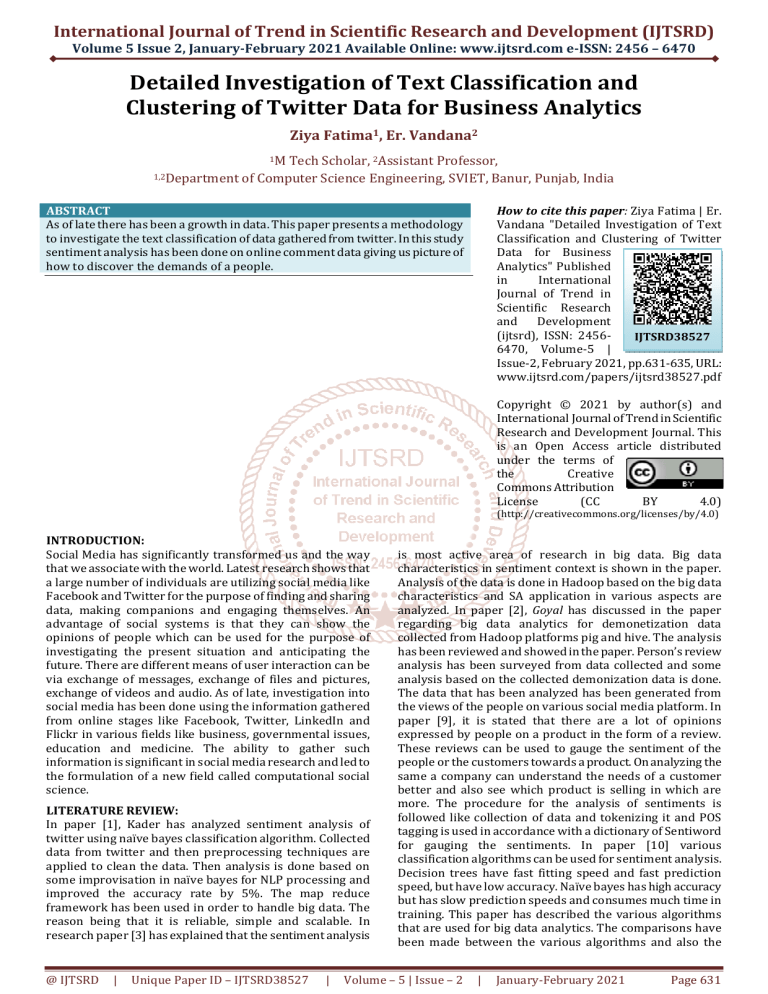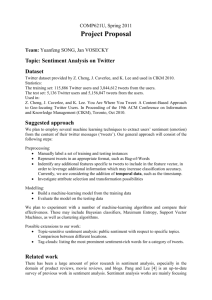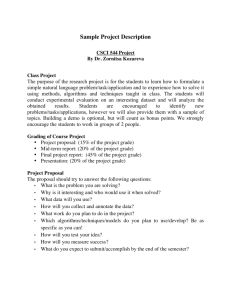
International Journal of Trend in Scientific Research and Development (IJTSRD)
Volume 5 Issue 2, January-February 2021 Available Online: www.ijtsrd.com e-ISSN: 2456 – 6470
Detailed Investigation of Text Classification and
Clustering of Twitter Data for Business Analytics
Ziya Fatima1, Er. Vandana2
1M
Tech Scholar, 2Assistant Professor,
1,2Department of Computer Science Engineering, SVIET, Banur, Punjab, India
ABSTRACT
As of late there has been a growth in data. This paper presents a methodology
to investigate the text classification of data gathered from twitter. In this study
sentiment analysis has been done on online comment data giving us picture of
how to discover the demands of a people.
How to cite this paper: Ziya Fatima | Er.
Vandana "Detailed Investigation of Text
Classification and Clustering of Twitter
Data for Business
Analytics" Published
in
International
Journal of Trend in
Scientific Research
and
Development
(ijtsrd), ISSN: 2456IJTSRD38527
6470, Volume-5 |
Issue-2, February 2021, pp.631-635, URL:
www.ijtsrd.com/papers/ijtsrd38527.pdf
Copyright © 2021 by author(s) and
International Journal of Trend in Scientific
Research and Development Journal. This
is an Open Access article distributed
under the terms of
the
Creative
Commons Attribution
License
(CC
BY
4.0)
(http://creativecommons.org/licenses/by/4.0)
INTRODUCTION:
Social Media has significantly transformed us and the way
that we associate with the world. Latest research shows that
a large number of individuals are utilizing social media like
Facebook and Twitter for the purpose of finding and sharing
data, making companions and engaging themselves. An
advantage of social systems is that they can show the
opinions of people which can be used for the purpose of
investigating the present situation and anticipating the
future. There are different means of user interaction can be
via exchange of messages, exchange of files and pictures,
exchange of videos and audio. As of late, investigation into
social media has been done using the information gathered
from online stages like Facebook, Twitter, LinkedIn and
Flickr in various fields like business, governmental issues,
education and medicine. The ability to gather such
information is significant in social media research and led to
the formulation of a new field called computational social
science.
LITERATURE REVIEW:
In paper [1], Kader has analyzed sentiment analysis of
twitter using naïve bayes classification algorithm. Collected
data from twitter and then preprocessing techniques are
applied to clean the data. Then analysis is done based on
some improvisation in naïve bayes for NLP processing and
improved the accuracy rate by 5%. The map reduce
framework has been used in order to handle big data. The
reason being that it is reliable, simple and scalable. In
research paper [3] has explained that the sentiment analysis
@ IJTSRD
|
Unique Paper ID – IJTSRD38527
|
is most active area of research in big data. Big data
characteristics in sentiment context is shown in the paper.
Analysis of the data is done in Hadoop based on the big data
characteristics and SA application in various aspects are
analyzed. In paper [2], Goyal has discussed in the paper
regarding big data analytics for demonetization data
collected from Hadoop platforms pig and hive. The analysis
has been reviewed and showed in the paper. Person’s review
analysis has been surveyed from data collected and some
analysis based on the collected demonization data is done.
The data that has been analyzed has been generated from
the views of the people on various social media platform. In
paper [9], it is stated that there are a lot of opinions
expressed by people on a product in the form of a review.
These reviews can be used to gauge the sentiment of the
people or the customers towards a product. On analyzing the
same a company can understand the needs of a customer
better and also see which product is selling in which are
more. The procedure for the analysis of sentiments is
followed like collection of data and tokenizing it and POS
tagging is used in accordance with a dictionary of Sentiword
for gauging the sentiments. In paper [10] various
classification algorithms can be used for sentiment analysis.
Decision trees have fast fitting speed and fast prediction
speed, but have low accuracy. Naïve bayes has high accuracy
but has slow prediction speeds and consumes much time in
training. This paper has described the various algorithms
that are used for big data analytics. The comparisons have
been made between the various algorithms and also the
Volume – 5 | Issue – 2
|
January-February 2021
Page 631
International Journal of Trend in Scientific Research and Development (IJTSRD) @ www.ijtsrd.com eISSN: 2456-6470
applications of the same have been described. In paper [6],
the author has used the Naïve Bayes Algorithm for the
purpose of classification of dataset in order to derive
information that is of great help in checking the sentiments
of the people towards a certain issue. The MapReduce of
Hadoop technology has been used. Preprocessing of the data
set and tokenization are done after the data has been
extracted from twitter. In the two phases of map reduce, the
first phase i.e. mapping is used for token generation of the
overall post or tweet. In the second phase i.e. reducing
classes for categorization are created and emoticons are
converted to text. The efficiency is increased. In paper [7],
Twitter’s API is used to derive data from twitter. Then the
data undergoes some processing. First removal of stop
words is done. Then the tokens are changed into a
structured form as they are mostly in unstructured form.
Then emoticons are also translated for higher accuracy. Then
Map-Reduce is used to find sentiment of each word and the
sum gives the overall sentiment of the tweet. In paper [8]
first map-reduce, a sentence is detected and stop words,
hashtags etc. are removed. Then we search for words which
represent features and are then clustered. Then Open NLP is
used for POS Tagging. Phrase removal is done before stop
word removal. In second map-reduce, a sentiwordnet
dictionary is used, scores are given to words, which is
averaged then to get overall value. In paper [5], has
examined the sentiment of youngsters regarding the floods
in Chennai in 2016. They used flume to get data from twitter
and applying Naïve Bayes algorithm. They developed a
dictionary to compare the tweets with and get a sentiment
score. In paper [4] various methods and concepts of
sentiment analysis on big data are showed. It has two
approaches- Lexicon based and Machine Learning based. The
machine learning approach is more popular and uses various
supervised and unsupervised learning algorithms.
RESEARCH METHODOLOGY USED:
Data Collection: Data is available in abundance via the
internet today. In today’s competitive world, none of the data
can be considered as not useful. It is a resource that if
utilized in a proper manner can provide great results and
benefits to a company. The data in this work has been
collected from twitter using the twitter API. Twitter data has
been used as it is mostly text.
Filtering/Prior Processing: The data that is collected from
twitter is not in a form which can directly produce results.
This data this is required to be filtered for removal of parts
which are of no use to generate results. This includes
removal of hashtags, stop words, marks of punctuation etc.
Feature Optimization: This process helps in the
construction of a model. It helps in reducing the training
time of the designed model. This works on the concept that
there might be some parts in a dataset that are repeated over
and over again or that might not show any relevance to the
topic at hand. Minimization of error rate is also a part of this
process.
Classification Using SVM: Classification is important when
it comes to categorization of text or recognizing the tone,
classification of images and so on. In this work support
vector machine (SVM) has been used. It is a powerful tool
when analyzing data. Several metrics are used for measuring
the performance. The used metrics are accuracy, precision,
recall.
Figure 1: Flowchart for the Methodology Proposed.
SIMULATED RESULTS AND DISCUSSION:
The first step is to load the dataset in order to perform the analysis on the same. The dataset is loaded in order to remove the
stop words so that result accuracy is improved. The sample data taken has been generated from twitter. The tweets of many
@ IJTSRD
|
Unique Paper ID – IJTSRD38527
|
Volume – 5 | Issue – 2
|
January-February 2021
Page 632
International Journal of Trend in Scientific Research and Development (IJTSRD) @ www.ijtsrd.com eISSN: 2456-6470
users have been taken which contain any information related to tax. This extracted data is then used to perform the analysis so
as to understand the opinions of various people on the related issue or topic. The sentiment are further grouped on the polarity
using feature optimization.
Figure 2: Loading the dataset
Figure 3: Identifying the words.
After loading the dataset the process of opinion mining or what we call sentiment analysis starts. The stop words and stem
words are identified followed by positive and negative words. The time taken depends on the size of the dataset. Feature
selection helps in achieving a better performance and leads to more accuracy. Processing the dataset has been done using SVM
and feature selection and ANN. The polarity results that follow clearly show the results based on polarity of the sentiments
expressed by the people. And SVM performs better.
@ IJTSRD
|
Unique Paper ID – IJTSRD38527
|
Volume – 5 | Issue – 2
|
January-February 2021
Page 633
International Journal of Trend in Scientific Research and Development (IJTSRD) @ www.ijtsrd.com eISSN: 2456-6470
Figure 4: Results based on SVM and ANN.
Figure 5: Evaluation of Results.
The results are further evaluated. A comparison has been made between the accuracy of the predicted results and the actual
results generated. Also a Comparison between the performances of SVM and ANN has been made. The results are displayed in
the figure that follows.
Figure 6: Accuracy Measure and Comparison.
A text mining approach thus using SVM algorithm has been done with feature selection. This is done with a view of getting the
SVM environment work in a much way that is to perform better. The proposed technique performs much better than the
existing technique.
@ IJTSRD
|
Unique Paper ID – IJTSRD38527
|
Volume – 5 | Issue – 2
|
January-February 2021
Page 634
International Journal of Trend in Scientific Research and Development (IJTSRD) @ www.ijtsrd.com eISSN: 2456-6470
CONCLUSION AND FUTURE SCOPE:
The outcome of evidence-based decision making contributes
to the improvement of a brand. Having a text analysis of tax
data allows effective quality management. With sentiment
analysis, companies can now strategically reposition their
businesses according to customers’ sentiments.
This work provided an introduction and rationale behind the
value of text analytics of Twitter data to businesses. The
work presented in this dissertation also discussed several
related work in sentiment analysis for business applications.
Importantly, it demonstrated a practical application of text
classification and clustering of Twitter data, and revealed
ways on how to analyze these to gain business insights.
Although the classification accuracy rate for this experiment
is already acceptable in this application domain.
It is suggested that future work needs to increase the
accuracy of the classification model by improving data
preparation and experimenting with other classification
algorithms.Also,tweets on some different issues can be taken
into consideration for more analysis of sentiments. Also,
some deep learning techniques to use to improve the
prediction accuracy and more optimize the results. The same
approach can be used with emotion mining also in which
number of class parameters are more than three.
REFRENCES:
[1] Mariam Khader, Arafat Awajan, Ghazi Al-Naymat,
“The Effects of Natural Language Processing on
Big Data Analysis: Sentiment Analysis Case Study”,
International Arab Conference on Information
Technology (ACIT), 2018.
[2]
[3]
MalvikaGoyal and Anuranjana, “DemonetizationTwitter Data Analysis using Big Data & Hadoop”,
Amity International Conference on Artificial
Intelligence (AICAI), 2019.
Imane El Alaoui, Youssef Gahi, RochdiMessoussi, “Full
Consideration of Big Data Characteristics in
Sentiment Analysis Context”, IEEE 4th International
Conference on Cloud Computing and Big Data
Analysis (ICCCBDA), 2019.
@ IJTSRD
|
Unique Paper ID – IJTSRD38527
|
[4]
M. Edison, A. Aloysius, “Concepts and Methods of
Sentiment Analysis on Big Data”, International
Journal of Innovative Research in Science Engineering
and Technology, Vol. 5, Issue 9, September 2016, pp.
16288-16296.
[5]
Priya. V, S DivyaVandana, “Chennai Rains
Sentiment-An Analysis Of Opinion About
Youngsters Reflected In Tweets Using Hadoop”,
International Journal of Pharmacy & Technology, Sep2016, Vol. 8, Issue No.3, pp. 16172-16180.
[6]
Huma Pandey and Shikha Pandey, “Sentiment
Analysis on Twitter Data-set using Naive Bayes
Algorithm”, IEEE, 2nd International Conference on
Applied
and
Theoretical
Computing
and
Communication Technology, 2016, pp. 416-419.
[7]
DivyaSehgal and Dr. Ambuj Kumar Agarwal,
“Sentiment Analysis of Big Data Applications using
Twitter Data with the Help of HADOOP
Framework”, IEEE, 5th International Conference on
System Modelling & Advancement in Research
Trends, 25th -27th November, 2016, pp. 251-255.
[8]
Jalpa Mehta, JayeshPatil, RuteshPatil, MansiSomani
and SheelVarma, “Sentiment Analysis on Product
Reviews using Hadoop”, International Journal of
Computer Applications Volume 142 – No.11, May
2016, pp. 38-41
[9]
Dr. U Ravi Babu, “Sentiment Analysis of reviews for
E-Shopping Websites”, International Journal of
Engineering and Computer Science, Volume 6 Issue 1
Jan. 2017, pp. 19965-19968.
[10]
HardiRajnikantThakor, “A Survey Paper on
Classification Algorithms in Big Data”,
International Journal of Research Culture Society,
Volume 1, Issue 3, May 2017, pp. 21 -27
[11]
Shawn Graham, Ian Milligan and Scott B. Weingart
“Exploring Big Historical Data - The Historian's
Macroscope”, London: Imperial College Press, 2016.
Volume – 5 | Issue – 2
|
January-February 2021
Page 635


